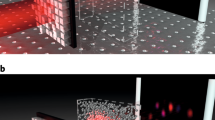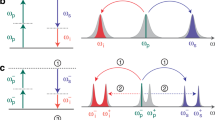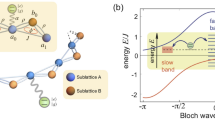Abstract
The interaction between electromagnetic fields and randomly structured matter is at the core of many natural phenomena. In the steady state, its microscopic description involves the superposition of the incoming radiation and the field due to the presence of the material system. Owing to reciprocity, this secondary emission manifests a striking coherent feature leading to an enhancement of backward intensity. This portrayal is complicated when the incident field is suddenly shut off since the outcome depends on both the spatial and temporal properties of radiation. Here we demonstrate that a directional memory of the incoming field persists long after the incident radiation ceases to be present within a spatially bounded medium. Our results reveal that a coherent back-emission emerges as a result of subradiant quasi-modes of an electromagnetic field located primarily in the vicinity of the medium’s interface. The paradigm is general and complements the rich phenomenology of light interaction with strongly scattered matter. The temporal and spatial properties of this long-lived, reciprocity-maintaining radiation depend on the type of illumination, which opens up new opportunities for memory applications.
This is a preview of subscription content, access via your institution
Access options
Access Nature and 54 other Nature Portfolio journals
Get Nature+, our best-value online-access subscription
$29.99 / 30 days
cancel any time
Subscribe to this journal
Receive 12 print issues and online access
$209.00 per year
only $17.42 per issue
Buy this article
- Purchase on Springer Link
- Instant access to full article PDF
Prices may be subject to local taxes which are calculated during checkout




Similar content being viewed by others
Data availability
All the data used within this paper are available from the corresponding author upon reasonable request.
Change history
27 January 2022
A Correction to this paper has been published: https://doi.org/10.1038/s41566-022-00962-8
References
Kuga, Y. & Ishimaru, A. Retroreflectance from a dense distribution of spherical particles. J. Opt. Soc. Am. A 1, 831–835 (1984).
Van Albada, M. P. & Lagendijk, A. Observation of weak localization of light in a random medium. Phys. Rev. Lett. 55, 2692–2695 (1985).
Wolf, P. E. & Maret, G. Weak localization and coherent backscattering of photons in disordered media. Phys. Rev. Lett. 55, 2696–2699 (1985).
De Vries, P., Van Coevorden, D. V. & Lagendijk, A. Point scatterers for classical waves. Rev. Mod. Phys. 70, 447–466 (1998).
Ellis, J. & Dogariu, A. Optical polarimetry of random fields. Phys. Rev. Lett. 95, 203905 (2005).
Feynman, R. P., Leighton, R. B., & Sands, M. The Feynman Lectures on Physics Vol. I (Basic Books, 2011).
Jackson, J. D. Classical Electrodynamics (Wiley, 1999).
Thirunamachandran, T. Intermolecular interactions in the presence of an intense radiation field. Mol. Phys. 40, 393–399 (1980).
O’dell, D., Giovanazzi, S., Kurizki, G. & Akulin, V. M. Bose–Einstein condensates with 1/r interatomic attraction: electromagnetically induced “gravity”. Phys. Rev. Lett. 84, 5687–5690 (2000).
Luis-Hita, J. et al. Light induced inverse-square law interactions between nanoparticles:“mock gravity” at the nanoscale. Phys. Rev. Lett. 123, 143201 (2019).
Shevchenko, A., Roussey, M., Friberg, A. T. & Setälä, T. Polarization time of unpolarized light. Optica 4, 64–70 (2017).
Cipris, A., Bachelard, R., Kaiser, R. & Guerin, W. Van der Waals dephasing for Dicke subradiance in cold atomic clouds. Phys. Rev. A 103, 033714 (2021).
Ishimaru, A. Wave Propagation and Scattering in Random Media (Academic, 1978).
Lehmberg, R. H. Radiation from an N-atom system. I. General formalism. Phys. Rev. A 2, 883–888 (1970).
Agarwal, G. S. Quantum Statistical Theories of Spontaneous Emission and Their Relation to Other Approaches (Springer, 1974).
Svidzinsky, A. A., Chang, J. T. & Scully, M. O. Cooperative spontaneous emission of N atoms: many-body eigenstates, the effect of virtual Lamb shift processes, and analogy with radiation of N classical oscillators. Phys. Rev. A 81, 053821 (2010).
Skipetrov, S. E. & Goetschy, A. Eigenvalue distributions of large Euclidean random matrices for waves in random media. J. Phys. A Math. Theor. 44, 065102 (2011).
Goetschy, A. & Skipetrov, S. E. Non-Hermitian Euclidean random matrix theory. Phys. Rev. E 84, 011150 (2011).
Fox, A. G. & Li, T. Resonant modes in a maser interferometer. Bell Syst. Tech. J. 40, 453–488 (1961).
Mishchenko, M. I. et al. Electromagnetic scattering by a morphologically complex object: fundamental concepts and common misconceptions. J. Quant. Spectrosc. Radiat. Transf. 112, 671–692 (2011).
Wiersma, D. S., van Albada, M. P., van Tiggelen, B. A. & Lagendijk, A. Experimental evidence for recurrent multiple scattering events of light in disordered media. Phys. Rev. Lett. 74, 4193–4196 (1995).
Akkermans, E., Wolf, P. E., Maynard, R. & Maret, G. Theoretical study of the coherent backscattering of light by disordered media. J. Phys. (Paris) 49, 77–98 (1988).
Prasad, S. & Glauber, R. J. Coherent radiation by a spherical medium of resonant atoms. Phys. Rev. A 82, 063805 (2010).
Schilder, N. J. et al. Polaritonic modes in a dense cloud of cold atoms. Phys. Rev. A 93, 063835 (2016).
Kwong, C. C. et al. Cooperative emission of a coherent superflash of light. Phys. Rev. Lett. 113, 223601 (2014).
Jennewein, S. et al. Coherent scattering of near-resonant light by a dense, microscopic cloud of cold two-level atoms: experiment versus theory. Phys. Rev. A 97, 053816 (2018).
Corey, R., Kissner, M. & Saulnier, P. Coherent backscattering of light. Am. J. Phys. 63, 560–564 (1995).
Weiss, P., Cipris, A., Araújo, M. O., Kaiser, R. & Guerin, W. Robustness of Dicke subradiance against thermal decoherence. Phys. Rev. A 100, 033833 (2019).
Tourin, A., Derode, A., Roux, P., Van Tiggelen, B. A. & Fink, M. Time-dependent coherent backscattering of acoustic waves. Phys. Rev. Lett. 79, 3637–3639 (1997).
Akkermans, E., & Montambaux, G. Mesoscopic Physics of Electrons and Photons (Cambridge Univ. Press, 2007).
Fearn, H., James, D. F. & Milonni, P. W. Microscopic approach to reflection, transmission, and the Ewald–Oseen extinction theorem. Am. J. Phys. 64, 986–995 (1996).
Rainò, G. et al. Superfluorescence from lead halide perovskite quantum dot superlattices. Nature 563, 671–675 (2018).
Durand, M., Popoff, S. M., Carminati, R. & Goetschy, A. Optimizing light storage in scattering media with the dwell-time operator. Phys. Rev. Lett. 123, 243901 (2019).
Yu, S., Qiu, C. W., Chong, Y., Torquato, S. & Park, N. Engineered disorder in photonics. Nat. Rev. Mater. 6, 226–243 (2021).
Acknowledgements
This work was partially supported by the Defense Advanced Research Projects Agency (DARPA) and the Office of Naval Research (N00014-20-1-2789).
Author information
Authors and Affiliations
Contributions
Both authors developed the idea and prepared the manuscript. Z.S. conducted the numerical calculations and A.D. supervised the project.
Corresponding author
Ethics declarations
Competing interests
The authors declare no competing interests.
Peer review
Peer review information
Nature Photonics thanks Jean-Jacques Greffet and the other, anonymous, reviewer(s) for their contribution to the peer review of this work.
Additional information
Publisher’s note Springer Nature remains neutral with regard to jurisdictional claims in published maps and institutional affiliations.
Supplementary information
Supplementary Information
Supplementary Figs. 1–5 and discussions.
Supplementary Video 1
The concept of coupled scatterers illuminated by Dirac δ pulse.
Supplementary Video 2
The concept of coupled scatterers illuminated by Heaviside H pulse.
Supplementary Video 3
The intensity dynamics for spherical random media (mean distance: 2.4λ, media radius: 7.5λ) illuminated by δ pulse.
Supplementary Video 4
The intensity dynamics for spherical random media (mean distance: 1.2λ, media radius: 3.8λ) illuminated by δ pulse.
Supplementary Video 5
The intensity dynamics for spherical random media (mean distance: 0.3λ, media radius: 0.9λ) illuminated by δ pulse.
Supplementary Video 6
The intensity dynamics for spherical random media (mean distance: 2.4λ, media radius: 7.5λ) illuminated by H pulse.
Supplementary Video 7
The intensity dynamics for spherical random media (mean distance: 1.2λ, media radius: 3.8λ) illuminated by H pulse.
Supplementary Video 8
The intensity dynamics for spherical random media (mean distance: 0.3λ, media radius: 0.9λ) illuminated by H pulse.
Supplementary Video 9
The intensity dynamics for spherical random media (mean distance: 0.6λ, media radius: 3.8λ) illuminated by δ pulse.
Supplementary Video 10
The intensity dynamics for spherical random media (mean distance: 0.3λ, media radius: 3.8λ) illuminated by δ pulse.
Supplementary Video 11
The intensity dynamics for spherical random media (mean distance: 0.6λ, media radius: 3.8λ) illuminated by H pulse.
Supplementary Video 12
The intensity dynamics for spherical random media (mean distance: 0.3λ, media radius: 3.8λ) illuminated by H pulse.
Supplementary Video 13
The intensity dynamics for cylindrical random media (mean distance: 0.3λ) illuminated by δ pulse (incidence angle: 45 deg).
Supplementary Video 14
The intensity dynamics for cylindrical random media (mean distance: 0.3λ) illuminated by H pulse (incidence angle: 45 deg).
Supplementary Video 15
The energy storage for spherical random media (mean distance: 0.6λ, media radius: 3.8λ) illuminated by δ pulse.
Supplementary Video 16
The energy storage for spherical random media (mean distance: 0.3λ, media radius: 3.8λ) illuminated by δ pulse.
Supplementary Video 17
The energy storage for spherical random media (mean distance: 0.6λ, media radius: 3.8λ) illuminated by H pulse.
Supplementary Video 18
The energy storage for spherical random media (mean distance: 0.3λ, media radius: 3.8λ) illuminated by H pulse.
Rights and permissions
About this article
Cite this article
Shen, Z., Dogariu, A. Subradiant directional memory in cooperative scattering. Nat. Photon. 16, 148–153 (2022). https://doi.org/10.1038/s41566-021-00926-4
Received:
Accepted:
Published:
Issue Date:
DOI: https://doi.org/10.1038/s41566-021-00926-4
This article is cited by
-
Many-body cavity quantum electrodynamics with driven inhomogeneous emitters
Nature (2023)
-
Multiplexed spatially-focused localization of light in adipose biological tissues
Scientific Reports (2022)
-
The show must go on
Nature Photonics (2022)



